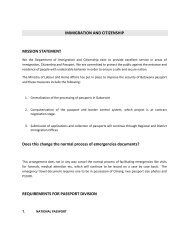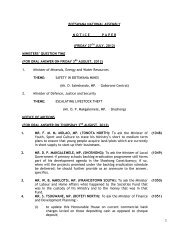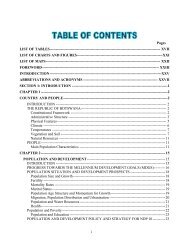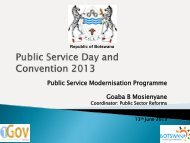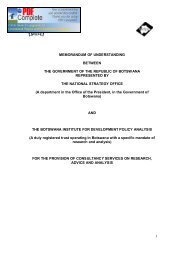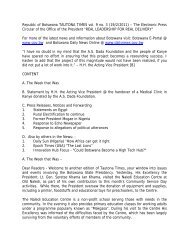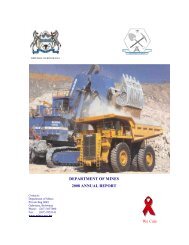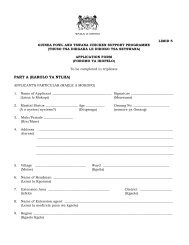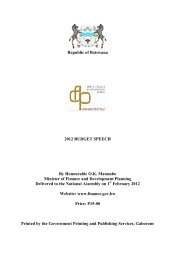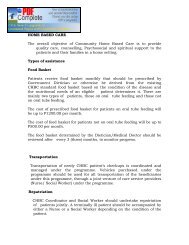Roads Department - Government of Botswana
Roads Department - Government of Botswana
Roads Department - Government of Botswana
Create successful ePaper yourself
Turn your PDF publications into a flip-book with our unique Google optimized e-Paper software.
<strong>Roads</strong> <strong>Department</strong><br />
3.2.1 Water Samples:<br />
Water samples should be taken from near the surface <strong>of</strong> water sources to be<br />
used for construction.<br />
Approximately 0.5 litres <strong>of</strong> water is normally adequate for most routine salt<br />
content analysis. Water samples should be taken and tightly sealed in a nontransparent<br />
glass or plastic bottle. Water samples exposed to the sun may<br />
attract algal growth. Such algae may feed on the salt and reduce the salt content<br />
prior to laboratory testing. All water samples should ideally not be stored<br />
for more than four weeks before testing.<br />
Water samples should be taken from near<br />
the surface <strong>of</strong> water sources to be used for<br />
construction.<br />
Some aquifers with salinity levels exceeding<br />
that <strong>of</strong> sea water have been encountered along<br />
the Jwaneng - Ghanzi road. These are <strong>of</strong>ten<br />
overlain or underlain with fresh (non-saline) or<br />
brackish water aquifer.<br />
When samples are taken from boreholes during drilling, it is important to<br />
ensure that samples are taken from each water strike level. The samples should<br />
be taken immediately the water is struck to avoid contamination from other<br />
aquifers. Electrical conductivity tests should be carried out on site using<br />
portable conductivity metres. Much <strong>of</strong> the groundwater present in western<br />
<strong>Botswana</strong> is ancient groundwater with variable levels <strong>of</strong> salinity.<br />
3.2.2 Soil Samples:<br />
Natural gravel from Borrow Pits<br />
Approximately 50 to 100 gram samples are adequate for routine conductivity<br />
and TDS testing depending on grain size <strong>of</strong> selected gravels.<br />
Samples used for salt testing should be taken from exploratory holes. A separate<br />
sample should be taken from the top 50mm <strong>of</strong> the upper most horizon<br />
encountered in the soil pr<strong>of</strong>ile.<br />
It would normally be adequate to assess the salinity level <strong>of</strong> a borrow pit on the<br />
basis <strong>of</strong> 3 to 8 full salt content tests (depending on size <strong>of</strong> borrow pit and local<br />
environment).<br />
3.3 Field Salt Content Tests<br />
3.3.1 Field Electrical Conductivity test<br />
Electrical conductivity tests can be carried out very quickly in the field using<br />
the quick conductivity test method. This provides a good measure <strong>of</strong> salt content<br />
in water or soil which correlates well with more elaborate laboratory tests.<br />
The methodology for field conductivity tests is relatively simple and is given<br />
in Appendix B. The equipment required can be carried in a small wooden case<br />
or brief case and comprises:<br />
Hand held conductivity metre, is an accurate<br />
and quick method to measure salt content.<br />
Hand held conductivity metre,<br />
Porcelain conductivity cup,<br />
Stirrer, spatula, bottle <strong>of</strong> distilled water and a wash bottle.<br />
Electrical conductivity may be related directly to salt damage potential because<br />
it measures only those salts which are soluble and can migrate in solution<br />
to the road surface where crystallisation occurs. E.C can therefore be used<br />
directly as an indicator <strong>of</strong> salt damage potential. As such, it can be used to<br />
assess whether preventative measures are required or not.<br />
26 Chapter 3<br />
Guide to the Prevention and Repair <strong>of</strong> Salt Damage to <strong>Roads</strong> and Runways<br />
Laboratory and Field Testing for Salt



